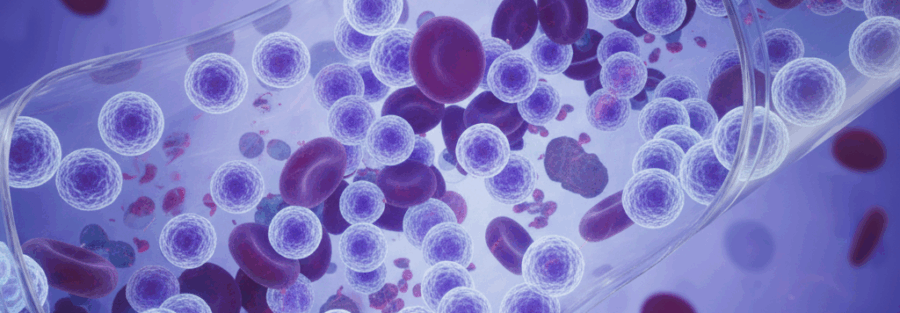“I had a routine check-up. My family doctor told me to see a hematologist, because my white blood cell count was high. I feel perfectly fine otherwise.”
“A simple flu turned into pneumonia. During the blood work, my pulmonologist noticed my white blood cells were elevated and sent me to haematology.”
“I’ve had a few small lumps in my neck for a while. Lately they seem bigger. I was scared to see a doctor.”
There are many ways people arrive in my office. Most are ordinary: a routine test, an elevated white blood cell count (WBC), and a worried person who otherwise feels well.
If you recognise yourself in these stories, you are not alone. Below are the ten questions my patients ask first, and how we approach them together.
1– What is Chronic Lymphocytic Leukaemia (CLL)?
CLL is a slow-growing cancer of mature B-lymphocytes. Many people feel well at diagnosis; we confirm it with blood tests and plan follow-up tailored to your situation.
2– What caused it?
There isn’t a single known cause.
Age and biology matter most. CLL is not contagious. Family clusters exist, but CLL is not typically inherited in a simple way. Environmental links are studied but rarely explain an individual case.
What you can do: Focus on what you can influence, such as: vaccinations, infection prevention, fitness, and follow-up.
3– What symptoms should I expect?
Many people have none.
Possible symptoms include painless enlarged nodes, fatigue, fevers or night sweats, weight loss, or frequent infections. Symptoms often evolve slowly; we watch trend and impact on daily life.
What you can do: Keep a simple symptom log (energy, fevers, sweats, weight). Bring it to appointments, it helps decisions.
4– Are my children at risk?
Risk is slightly higher than the general population, but most relatives never develop CLL.
Having a first-degree relative with CLL raises risk modestly. We don’t recommend routine screening for family members unless there’s a research context or unusual patterns.
What you can do: Reassure loved ones. Encourage general health checks as usual.
5– What tests should I undergo now?
Blood flow cytometry confirms CLL; genetics guide treatment.
Let’s list the tests below:
- Flow cytometry: typical markers include CD5, CD19, CD23 with light-chain restriction.
- Before first treatment: we check TP53 status (del17p/TP53 mutation), IGHV mutation status, and FISH panel (del13q, +12, del11q, del17p). These results strongly influence the plan.
- Imaging/bone marrow: done if it changes management; not always needed up front.
What you can do: Ask, “Do I have TP53 disruption or unmutated IGHV? How will that affect choices?”
6– Why aren’t we treating right away?
Because treating too early doesn’t help you live longer and adds side effects.
International criteria recommend active surveillance until there is “active” disease, meaning symptoms or objective signs that treatment will clearly help (see Q7).
What you can do: Embrace the plan. Surveillance is not “doing nothing”—it’s doing the right thing at the right time.
7– When do we start treatment?
When iwCLL (International Workshop on Chronic Lymphocytic Leukaemia) criteria are met.
Common triggers include:
- Persistent B-symptoms (fevers, drenching night sweats, weight loss)
- Symptomatic or rapidly progressive bulky lymph nodes or spleen
- Rapid Lymphocyte rise with disease-related issues
- CLL-related anemia (Hb <10 g/dL) or thrombocytopenia (Plt <100×10⁹/L)
What you can do: If any of the above appear or worsen, tell your haematologist promptly.
8– Can CLL be cured?
Usually it’s controlled rather than cured.
Modern targeted therapies achieve deep, long remissions; many people live decades with planned breaks from therapy. Curative approaches (like allogeneic transplant) are used only in select high-risk situations; cellular therapies (e.g., CAR-T) are evolving in trials.
What you can do: Ask whether a clinical trial is suitable for your stage and risk profile.
9– Should I change my daily routine?
Keep living your life smartly.
Here is how you can do it:
- Vaccines: stay current with inactivated vaccines; discuss timing relative to therapy.
- Infection prevention: hand hygiene; prompt attention to fevers; tailored antimicrobial advice during certain treatments.
- Lifestyle: exercise, sleep, nutrition, sun protection (skin-cancer vigilance is important in CLL).
What you can do: Create a personal health plan (vaccines, dental checks, skin checks, activity goals) and bring it to clinic.
10– What is my prognosis?
Highly individual, and often very good.
Stage and biology matter. TP53 disruption and unmutated IGHV indicate higher risk and favor certain therapies; mutated IGHV and isolated del(13q) generally predict a gentler course. With today’s options, many patients live long, full lives.
What you can do: Ask for a clear explanation of your risk features and what they mean for monitoring and treatment.
“Ask the Haematologist”
Bring these to your next visit:
- What do my TP53/IGHV/FISH results show?
- Do I meet treatment criteria now? If not, what’s our monitoring plan?
- Which option fits me best and why?
- How will we handle vaccines and infection prevention?
- Are there clinical trials that match my situation?
Remember:
CLL is rarely an emergency, and you don’t need to live in fear. With thoughtful monitoring and modern therapies, we can time treatment well and aim for long, good-quality years, often with stretches off medication. If you’re feeling overwhelmed, that’s normal. Let’s take it one step at a time, together.
References:
- ESMO–EHA CLL Clinical Practice Guidelines & 2024 eUpdate.
- iwCLL 2018 criteria for diagnosis and treatment initiation (still referenced in current algorithms).
- NCCN patient guideline (2025) for accessible summaries of current options.
- CLL14 long-term outcomes for venetoclax-obinutuzumab (fixed duration).
- BTK inhibitor comparisons and modern choices.
- Staging overviews (Rai/Binet) for lay readers.


